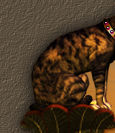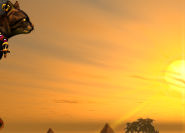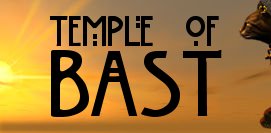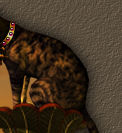Bast
Other Names: Bastet, Ailuros
Patron of: the sun (originally), the moon (after the Greeks), cats, women, and secrets.
Appearance: A desert cat, or a woman with the head of a cat (this form possibly dates after
the domestication of the Egyptian wild cat).
Description: Probably the most famous Egyptian goddess after Isis, Bast was said to be the
daughter of Ra, though long after he created the primal gods. She was originally a sun
goddess, but after contact with the Greeks, she changed to a moon goddess, probably due to
the Greeks associating her with Artemis.
Like Artemis, Bast was a wild goddess. To those who were in her favor, she gave great
blessings, but her wrath was legendary and she was sometimes listed as one of Ra's avenging
deities who punish the sinful and the enemies of Egypt. This is of course in keeping with her
totem animal, the cat. Cats were sacred to Bast, and to harm one was deemed a great
transgression. Bast's importance in the Egyptian pantheon might be due to the great value
placed on the domesticated cat by the Egyptians. Cats curtailed the spread of disease by
killing vermin, and though the idea of microbes was unknown to the ancient Egyptians, they
must have noticed the connection between rats and disease.
Her worship was widespread, and her cult apparently had a great deal of power. Bubastis was
even the capital of Egypt for a time during the Late Period, and some pharaohs took her name
in their king-names. Herodotus' description of her temple at Bubastis is that of a place of great
splendor and beauty, rivaled only by the temples to Ra and Horus.
The temple was considered the dwelling house of the god, it was a miniature picture of the world at the moment of creation. The temple was conceived as the center of creation. This symbolic role of the temple was expressed in its location and design as well as the decoration of its walls and ceiling. The structure was separated from the outside world by a massive mud brick enclosure wall which symbolize the watery state of the cosmos at creation. Within this lay the main wall or the entrance wall, decorated with scenes of the king slaughtering his enemies. The pylon is the largest element in the temple symbolizing the hieroglyph of the horizon with its two massive columns and the gap between them. The orientation of the temple was always east-west, therefore the sun rises in the pylon gateway penetrating with its rays to the sanctuary (or shrine in which the statue of the god was kept) which is placed in axis. The sanctuary represent the mound of creation. Therefore in passing through the temple, toward the sanctuary, one goes through the various phases of creation. The hypostyle hall encompasses the decorative scheme of the whole. The hall with its columns represented the marsh of creation while the ceiling is decorated with reliefs of the sky. On the walls, the activity of the world is represented, and in terms of the temple the give and take relation between the king and the god is the core of the world activity. There was a consistent general pattern of temple building. This pattern ensured a gradual approach was made to the divinity. The arrangement consisted of a gradual move from light to shadow, with a rise in the ground floor and lowering of the ceiling. The temple's daily ritual was a dramatization of the god's daily life. The main services at dawn, midday, and night consisted of washing, anointment, adornment with clothing and feeding of the deity with offerings. The great festivals represented the god's social life when he was taken in procession to visit another deity in his house or received such a visit. These procedures stand in sharp contrast with the religious practices of the majority of the Egyptians. In each of the main temples the Pharoah was regarded symbolically as the high priest.
The temple was considered the dwelling house of the god, it was a miniature picture of the world at the moment of creation. The temple was conceived as the center of creation. This symbolic role of the temple was expressed in its location and design as well as the decoration of its walls and ceiling. The structure was separated from the outside world by a massive mud brick enclosure wall which symbolize the watery state of the cosmos at creation. Within this lay the main wall or the entrance wall, decorated with scenes of the king slaughtering his enemies. The pylon is the largest element in the temple symbolizing the hieroglyph of the horizon with its two massive columns and the gap between them. The orientation of the temple was always east-west, therefore the sun rises in the pylon gateway penetrating with its rays to the sanctuary (or shrine in which the statue of the god was kept) which is placed in axis. The sanctuary represent the mound of creation. Therefore in passing through the temple, toward the sanctuary, one goes through the various phases of creation. The hypostyle hall encompasses the decorative scheme of the whole. The hall with its columns represented the marsh of creation while the ceiling is decorated with reliefs of the sky. On the walls, the activity of the world is represented, and in terms of the temple the give and take relation between the king and the god is the core of the world activity. There was a consistent general pattern of temple building. This pattern ensured a gradual approach was made to the divinity. The arrangement consisted of a gradual move from light to shadow, with a rise in the ground floor and lowering of the ceiling. The temple's daily ritual was a dramatization of the god's daily life. The main services at dawn, midday, and night consisted of washing, anointment, adornment with clothing and feeding of the deity with offerings. The great festivals represented the god's social life when he was taken in procession to visit another deity in his house or received such a visit. These procedures stand in sharp contrast with the religious practices of the majority of the Egyptians. In each of the main temples the Pharoah was regarded symbolically as the high priest.
The temple was considered the dwelling house of the god, it was a miniature picture of the world at the moment of creation. The temple was conceived as the center of creation. This symbolic role of the temple was expressed in its location and design as well as the decoration of its walls and ceiling. The structure was separated from the outside world by a massive mud brick enclosure wall which symbolize the watery state of the cosmos at creation. Within this lay the main wall or the entrance wall, decorated with scenes of the king slaughtering his enemies. The pylon is the largest element in the temple symbolizing the hieroglyph of the horizon with its two massive columns and the gap between them. The orientation of the temple was always east-west, therefore the sun rises in the pylon gateway penetrating with its rays to the sanctuary (or shrine in which the statue of the god was kept) which is placed in axis. The sanctuary represent the mound of creation. Therefore in passing through the temple, toward the sanctuary, one goes through the various phases of creation. The hypostyle hall encompasses the decorative scheme of the whole. The hall with its columns represented the marsh of creation while the ceiling is decorated with reliefs of the sky. On the walls, the activity of the world is represented, and in terms of the temple the give and take relation between the king and the god is the core of the world activity. There was a consistent general pattern of temple building. This pattern ensured a gradual approach was made to the divinity. The arrangement consisted of a gradual move from light to shadow, with a rise in the ground floor and lowering of the ceiling. The temple's daily ritual was a dramatization of the god's daily life. The main services at dawn, midday, and night consisted of washing, anointment, adornment with clothing and feeding of the deity with offerings. The great festivals represented the god's social life when he was taken in procession to visit another deity in his house or received such a visit. These procedures stand in sharp contrast with the religious practices of the majority of the Egyptians. In each of the main temples the Pharoah was regarded symbolically as the high priest.














